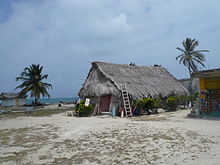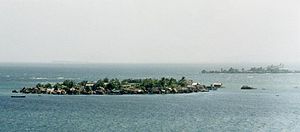San Blas Islands
| San Blas Islands | ||
|---|---|---|
| San Blas Islands | ||
| Waters | Caribbean Sea | |
| Geographical location | 9 ° 34 ′ N , 78 ° 49 ′ W | |
|
|
||
| Number of islands | approx. 365 | |
| Main island | El Porvenir | |
| Aerial view of the archipelago | ||


The San Blas Islands ( Spanish Archipiélago de San Blas ) are located in the Caribbean Sea and form an archipelago with around 365 islands (main island: El Porvenir ).
location
The San Blas Islands belong to the Comarca Guna Yala (former name: San Blas) east of the Panama Canal , an autonomous area that extends along the Panamanian Caribbean coast from El Porvenir to the Colombian border.
Flora and fauna
The majority of the tropical palm-covered islands are protected by coral reefs. With the underwater world still intact, this archipelago is rich in corals , crabs , lobsters , clams, and fish.
population
The San Blas Islands are inhabited and administered by around 25,000 kuna (also Cuna, in Colombia Tule), an indigenous ethnic group of Panama. They inhabit 57 islands belonging to 36 comunidades (whereby the island of Ustupu is divided into two comunidades ; the 13 remaining comunidades are on the mainland). San Blas is called "Guna Yala" by the Kuna in their own language.
history
The Kuna fled to this archipelago due to the Spanish invasion in the 17th century and later fought against the Spaniards on the side of other colonial powers . In the end, they successfully resisted Panama's government in bloody clashes and in 1930 were able to establish the Kuna Yala autonomous region.
Originally, the natives of the San Blas Islands hardly wore any clothes and adorned their bodies with colorful decorations. Missionaries then encouraged them to wear clothes, so that they finally designed their clothes, the molas , with the patterns of their body paints.
The community of the Kunas lives in matriarchy . So lives z. B. the husband in the wife's family after marriage. The Kuna have their own tribal language and a flag on which a swastika symbolizes the octopus that, according to the Kuna legend, created the world.
Economy and tourism
To this day, the Kuna live mainly from agriculture and fishing . They trade in fish, lobsters , giant crabs and coconuts . In addition, they sell their colorful molas, which are famous far beyond the borders of Panama and which can be worked on for up to six months. This artistic form of appliqué embroidery developed at the beginning of the 20th century.
The Tourism plays a minor role compared to other Caribbean islands in the San Blas Islands and is not designed for mass or luxury tourism. On the main island of El Porvenir there is a runway for small planes from Panama City and a hostel . From there you can take a boat to Wichub-Wala Island. The islands of Sapibenega and Okuptupu also have a small tourist infrastructure, whereas the islands in the south of the archipelago have not yet been developed for tourism (e.g. Ukupseni).
Islands
- Isla El Porvenir
- Isla Wichubualá (aka Wichub Wala or Huala)
- Isla Ukuptupu
- Isla Narangá
- Isla Corazón de Jesús
Web links
- Map sheet 1: 250,000
- Travel report (PDF; 1.3 MB)


